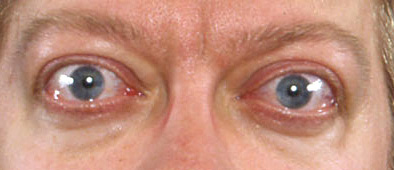Case history
Case history
A 38-year-old woman, who in the past had tried to lose weight without success, is happy to see that in the last 2 months she has lost 25 pounds. She also has difficulty sleeping at night. Her husband complains that she is keeping the house very cool. She recently consulted her ophthalmologist because of redness and watering of the eyes. Eye drops were not helpful. She consults her doctor for fatigue and anxiety, palpitations, and easy fatigability. On physical examination, her pulse rate is 100 bpm and her thyroid is slightly enlarged. Conjunctivae are red and she has a stare.
Other presentations
Older patients may present in a relatively asymptomatic way, although weight loss, atrial fibrillation, or myopathy may typically be present.[4] Some patients do not have an enlarged thyroid. Women may present with menstrual changes such as oligomenorrhea.[5] Men may develop gynecomastia. Patients may present with pedal edema or dyspnea without congestive heart failure.[6] Some patients may present with orbitopathy before developing hyperthyroid symptoms. People with subclinical Graves disease are mildly symptomatic or asymptomatic, with low serum thyroid-stimulating hormone (TSH), and free thyroid hormone levels within the reference range.[7][8][9] People with euthyroid Graves disease have orbitopathy or both orbitopathy and dermopathy with normal thyroid function tests.[2] Patients may have both hypothyroidism from autoimmune thyroiditis (Hashimoto disease) and extrathyroidal manifestations of Graves disease with orbitopathy, dermopathy, or acropachy.[10] Dermopathy and/or acropachy are almost never seen without orbitopathy. Rarely, patients can present with thyrotoxic periodic paralysis.[Figure caption and citation for the preceding image starts]: Lid retraction, mild proptosis, and mild chemosisCourtesy of Dr Vahab Fatourechi [Citation ends].
Use of this content is subject to our disclaimer